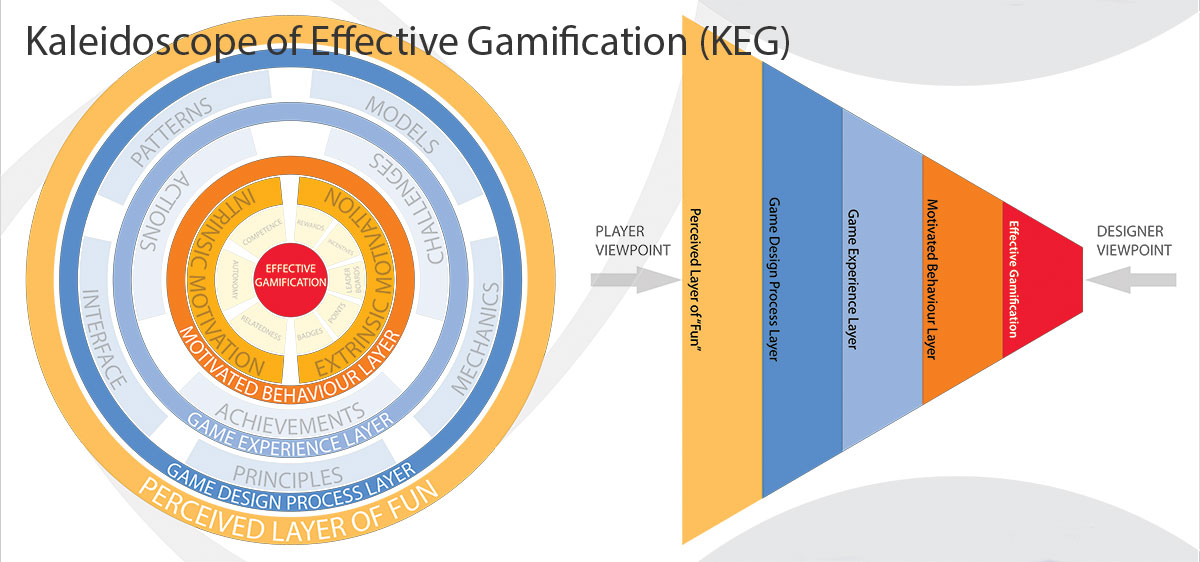An Effective Gamification Model
Publication:
Kappen, D. L., & Nacke, L. E. (2013). The Kaleidoscope of Effective Gamification: Deconstructing Gamification in Business Applications. In Proceedings of the First International Conference on Gameful Design, Research, and Applications – Gamification ’13 (pp. 119–122). https://doi.org/10.1145/2583008.2583029
As a starting point for this discussion on effective gamification, I examined a number of models in the following analysis. The mechanics-dynamics-aesthetics (MDA) (Hunicke, Leblanc, & Zubek, 2004) framework (a design-centric model) qualified the amalgamation of rules, the game system, and “fun”, where “fun” was the emotional response conforming to aesthetics. This model established the relationship between designer intent and player experience. However, designers were in need of clearer action guidelines for game design. Filling this gap, game design lenses (Schell, 2009) established a set of heuristics to enable game designers to create purposeful and engaging games. In the same context, Daniel Cook’s skill atoms formed the basic ingredients for creating a systemic interaction between game process design elements. I refer to the term game design process for this because the relationship between systems is a process in itself. On a linear hierarchical format, this combined model indicating these elements can be represented as shown in Figure 1.

Figure 1: Game Design Process Layer ((Hunicke et al., 2004; Schell, 2009))
When designing a gameplay experience with intrinsic and extrinsic stimuli as a focus, the designer must integrate actions, challenges (Heintz, 2012) and achievements (Hamari & Eranti, 2011) in the gamification design process. This would enable the creation of an engaging gameplay experience in a “gamified” application. The user experience derived in this layer is called the game experience layer (Figure 2). Based on the prior definition, goals represent an end state of achievement, actions represent steps taken to reach goals, challenges represent inherent tasks or obstacles within the system on the path to achieving said goals, and achievement represents the act of reaching one’s goal (Deterding, 2013).
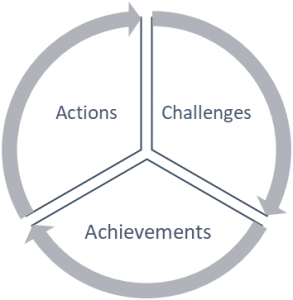
Figure 2: Game Experience Layer ((Hamari & Eranti, 2011; Heintz, 2012))
The motivational model of video game engagement (Przybylski, Rigby, & Ryan, 2010) (a psychological model) discussed the relationship between player need satisfaction and player motives. The paper compared player need satisfaction elements (i.e., competence, autonomy, and relatedness (Ryan & Deci, 2000)) to in-game motivational elements (achievement, socialization, and immersion) [110]. More specifically, the impact of achievements on player behaviour was investigated by the game achievement framework (Hamari & Eranti, 2011) (an economical model), defining achievements as a sequence of signifiers, completion logics, and rewards. Therefore, the motivated behaviour layer (Figure 3) comprised of intrinsic and extrinsic factors contributing to the motivation for the user to play the app or the non-game system.
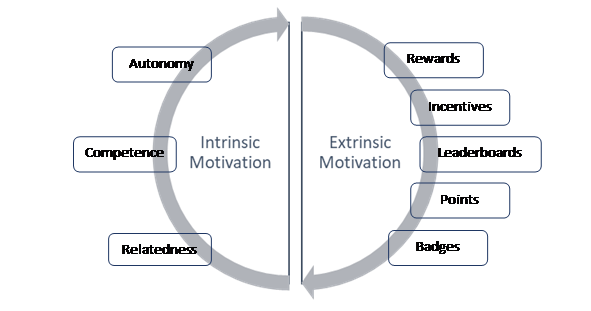
Figure 3: Motivated Behaviour Layer (MBL)
For the purposes of simplicity, the illustration of this layer (Figure 3) represents a 50% distribution for intrinsic and extrinsic motivation, which may not be the case and much research is needed to establish if there is a relevant ratio for these two dimensions. The extrinsic motivation elements were selected based on the most commonly used gamification elements in this construct (Deterding, 2013; Hamari, Koivisto, & Sarsa, 2014; Mekler, Br, Opwis, & Tuch, 2013).
Based on the layers shown above, I proposed a cumulative model in development for “effective gamification” based on Ryan et al. (Ryan & Deci, 2000); Deterding et al. (Deterding, Sicart, Nacke, O’Hara, & Dixon, 2011); Przybylski et al. (Przybylski et al., 2010); and Hamari et al. (Hamari & Eranti, 2011), with the addition of the “perceived layer of fun”, which comprises assimilated game design process elements to influence human behaviour through the incorporation of actions, challenges, and achievements. The representation of the framework was redesigned to establish a circular arrangement of the dimensions and elements to express the simplification of the complexity of the decision-making process, metaphorically similar to the visual complexity to ordered patterns in a kaleidoscope.
This model illustrates the interconnectedness of behavioural change through gamification elements. In this model, the layers of effective gamification—I use the term “layers” as analogous to the layers of an onion—converge to a central core. The model interspaces behavioural change at its core, where intrinsic and extrinsic motivations—being drivers for gameplay behaviour in different ratios—are both relevant for effective gamification.
Figure 7 establishes the complexity of interrelationship between rings, with the adjacent rings in a top-view relationship. Each layer is explained below, starting from the central core of the KEG model.
Effective Gamification Core. This core establishes the nucleus of player experience, relating to all successive model layers. It represents the core objectives of a design enabling effective gamification. To achieve effective gamification, a game designer entrusted with the task of gamification of an application or a service must aim for an optimum player experience (Nacke, Drachen, & Göbel, 2010) leading to effective gamification. These represent the objectives of a design brief where satisfying the motivation driving the needs and wants (Motivated Behaviour Layer) of the user converge to enable effective gamification.
Motivated Behaviour Layer. A game designer moves outward from this layer, in which they have to identify a user need that grounds an intrinsic and extrinsic motivation. The influencers of the intrinsic motivation category of this layer consist of competence, autonomy, and relatedness (Ryan & Deci, 2000) as shown in Figure 4. The influencers of the extrinsic motivation portion of this layer are composed of badges, points, leaderboards (Deterding et al., 2011), and rewards. This motivational behavioural influencer drives the next ring, the Game Experience Layer.
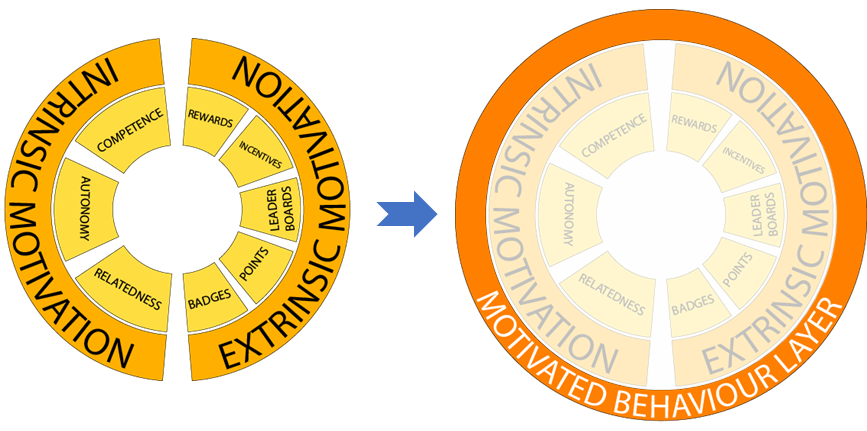
Figure 4: Motivated Behaviour Layer in the Illustration Format
Game Experience Layer. When designing a gameplay experience with intrinsic and extrinsic motivational stimuli as a focus, the designer integrates actions, challenges (Heintz, 2012), and achievements (Hamari & Eranti, 2011) in the gamification design process (Figure 5). This would enable the creation of an engaging gameplay experience in a “gamified” application. The user experience derived in this layer is dependent on the next ring, called the Game Design Process Layer.
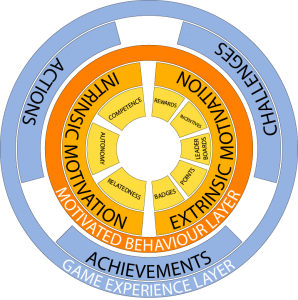
Figure 5: Game Experience Layer (GEL) with the Motivated Behaviour Layer (MBL)
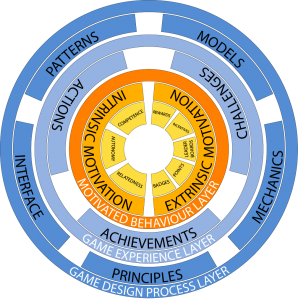
Figure 6: Game Process Layer with MBL and GPL
Game Design Process Layer. Instead of using the term game design elements (Deterding et al., 2011), I refer to this ring as the Game Design Process Layer (Figure 6). The elements in this ring serve as subsystems or lenses (Schell, 2009). Integrating these subsystems to create a fun experience for the user makes it necessary to identify this layer as a process. Game design principles, mechanics, models, patterns, and interface design elements (Deterding et al., 2011) serve as related sub-systems supporting this layer since they were designed to relate to the Game Experience Layer. Finally, all these layers interact together to form the Kaleidoscope of Effective Gamification (Kappen & Nacke, 2013), an iterative and layered model as shown in Figure 7.

Figure 7: Kaleidoscope of Effective Gamification (KEG) Model
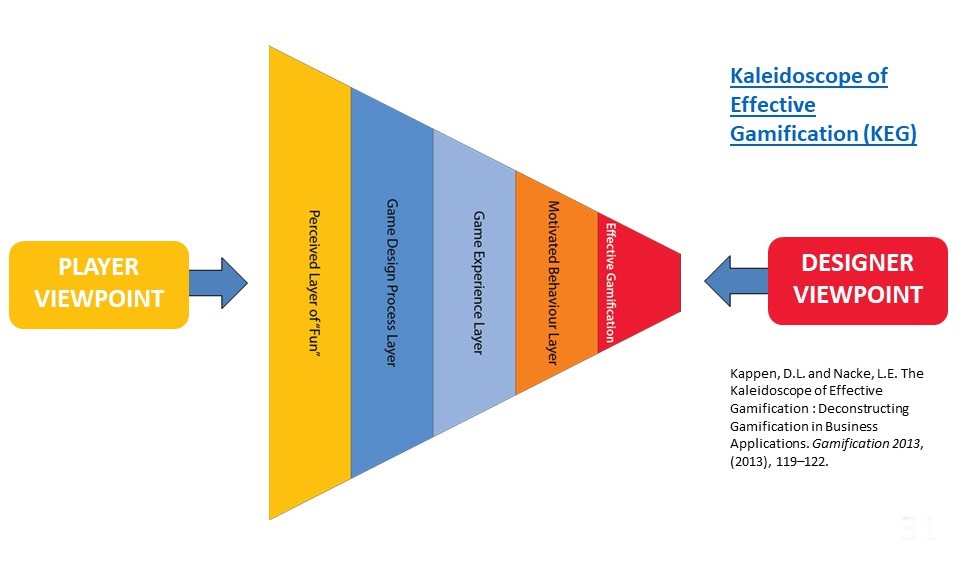
Figure 8: Player-Designer Vantage Point
Figure 8 shows the player viewpoint and the designer viewpoint of the gamification app necessary to build an effective gamification application. From the player’s perspective, unless there is a fun element which caters to their intrinsic motivations while engaging themselves in a mundane non-game application, it would be difficult to gain their attention and retain their interest in the gamified application.
Perceived Layer of Fun. This ring, the outermost layer, has a synergistic converging relationship with the innermost Motivated Behaviour Layer. Intrinsic motivation is a major influence for users to engage with a non-game application. A player progresses from the outermost ring, the Perceived Layer of Fun, which is what a player can see and aesthetically experience in terms of audio, visuals, interface design, tangible interactions, and intangible experiences. These experiences converge during gameplay through actions, challenges, and achievements that engage the player. Unless the player experiences motivation through a feeling of delight or fun when playing the game system, gamification is not effective. This is my understanding of the perceived layer of fun used in gamification practice and literature. The interactive and potentially immersive nature of gamified applications—that involves actions, challenges, and rewards—with the injection of “fun” —provides motivation to explore these applications (Kappen & Nacke, 2013).
A player, on the other hand, progresses from the outermost ring, the perceived layer of fun, which is what a player can see and experience in terms of audio, visuals, interface design, tangible interactions (game design process layer) and intangible experiences. These experiences (game experience layer) are assimilated into gameplay through actions, challenges (Heintz, 2012) and achievements (Hamari & Eranti, 2011) which encourages the player to be engaged in the game, influencing a motivated behaviour of the player. Unless the player experiences motivation through fun to play the game system, there is no effective gamification.
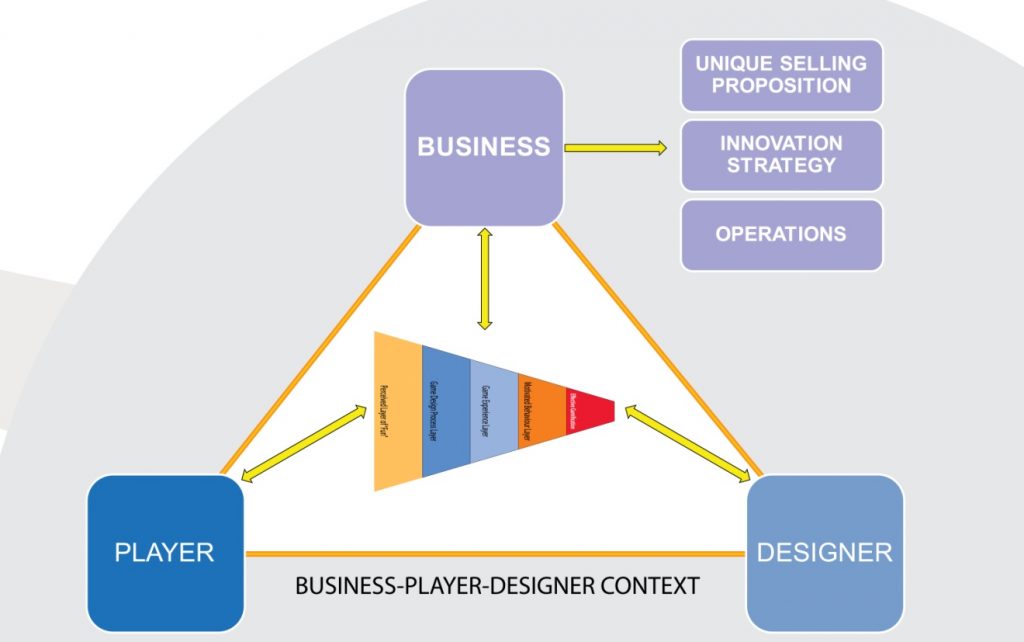
Figure 9: Business Model using KEG
Figure 9 illustrates a hypothetical interrelationship of how the KEG design model could be used with reference to establishing a unique selling proposition, innovation strategy and advertising operation for the application.
For effective gamification, however, I reproduce the following design guidelines which focussed on the design layers of my KEG model (Kappen & Nacke, 2013).
| Ring-Layer | Attribute | Guideline |
| Motivated Behaviour Layer | Intrinsic Motivation | Autonomy: Evaluate the needs to the demographic profile to identify values of personal importance to users such that their commitments to activities are internalized. |
| Intrinsic Motivation | Competence: Identify core values which enable users to enhance their capabilities and skills. | |
| Intrinsic Motivation | Relatedness: Create the possibility of social connectedness, acceptance and validation within the gamification application. | |
| Extrinsic Motivation | Badges, points, leaderboards, incentives and rewards are only of limited value. While your app can have these extrinsic motivation elements, ensure that there is an experience of “fun” and the element of surprise in procuring these elements. Tagging along these elements for the sake of a reward will have no value addition to the gamification application. Aesthetic representation is another important factor attached to these rewards. | |
| Game Experience Layer | Actions | Identify game mechanics, such as rules to stimulate intrinsic motivation of the user, strategies to indulge the user in getting excited about gameplay, and sustaining their interest throughout the game’s duration. All these sub-systems must integrate well with the motivated behaviour layer. |
| Challenges | Ensure that the rules identifying the game mechanics are relevant to the intrinsic motivation elements so that the drive to continue playing the gamification application is based on the user’s internal desires and aspirations. | |
| Achievements | Identify goals and objectives within the game that enhance the personal goals of the user and ensure its conformance to the motivated behaviour layer. | |
| Game Design Process Layer | Interface, Mechanics, Models, Principles | Identify goals within each subsystem to maximize the process of integrating subsystems to create a fun experience for the user, while ensuring motivation. |
| Perceived Layer of “Fun” | “Fun” | Identify the perceived layer of “fun”, such as excitable attributes, elements of surprise characteristics, fun in accomplishing milestones and the use of exciting hypermedia effects. These would influence and motivate the behaviour of the user through experiential and memorable gameplay of the gamification application. |
Table 1: Design Guidelines for Effective Gamification (Kappen & Nacke, 2013)
The “Perceived Layer of Fun” becomes a critical aspect of any gamification application, because this is the layer that the users experience. This layer must establish a close relationship with the motivational behaviour layer. The Game Design Process Layer must create memorable and “fun” experiences, which add value to the gamification process.
The KEG model represents an initial checklist of objectives that define integrated relationships between elements on each layer, which in turn establish vertical, three-dimensional relationships with the layers directly above and below. Thus, the framework demonstrates system relations between all layers. It also works as a design tool for game designers that need to gamify business apps and services as indicated in Figure 9. I validated these design guidelines by applying it to the development of a fitness application (Phase 3) and the study of motivations pertaining to PA engagement.
References
Deterding, S. (2013). The Lens of Intrinsic Skill Atoms : A Method for Gameful Design. HCI and Digital Games, 30(3–4), 27–55.
Deterding, S., Sicart, M., Nacke, L. E., O’Hara, K., & Dixon, D. (2011). Gamification. using game-design elements in non-gaming contexts. Proc of CHI EA ’11, 2425–2428. https://doi.org/10.1145/1979742.1979575
Hamari, J., & Eranti, V. (2011). Framework for Designing and Evaluating Game Achievements. In DiGRA 2011: Think Design Play (pp. 1–20). Retrieved from http://www.digra.org/wp-content/uploads/digital-library/11307.59151.pdf
Hamari, J., Koivisto, J., & Sarsa, H. (2014). Does Gamification Work? – A Literature Review of Empirical Studies on Gamification. Proceedings of the Annual Hawaii International Conference on System Sciences, 3025–3034. https://doi.org/10.1109/HICSS.2014.377
Heintz, S. (2012). Evaluating Design Elements for Digital Educational Games on Programming : A Pilot Study. In Proceedings BCS-HCI ’12 (pp. 245–250).
Hunicke, R., Leblanc, M., & Zubek, R. (2004). MDA : A Formal Approach to Game Design and Game Research. In Proc. of Challenges in Games AI Workshop (pp. 1–5).
Kappen, D. L., & Nacke, L. E. (2013). The Kaleidoscope of Effective Gamification: Deconstructing Gamification in Business Applications. In Proceedings of the First International Conference on Gameful Design, Research, and Applications – Gamification ’13 (pp. 119–122). https://doi.org/10.1145/2583008.2583029
Mekler, E. D., Br, F., Opwis, K., & Tuch, A. N. (2013). Do Points , Levels and Leaderboards Harm Intrinsic Motivation ? An Empirical Analysis of Common Gamification Elements. In Gamification 2013 (pp. 66–73).
Nacke, L. E., Drachen, A., & Göbel, S. (2010). Methods for Evaluating Gameplay Experience in a Serious Gaming Context. Journal of Computer Science in Sport, 9(2), 1–12.
Przybylski, A. K., Rigby, C. S., & Ryan, R. M. (2010). A motivational model of video game engagement. Review of General Psychology, 14(2), 154–166. https://doi.org/10.1037/a0019440
Ryan, R. M., & Deci, E. L. (2000). Intrinsic and Extrinsic Motivations: Classic Definitions and New Directions. Contemporary Educational Psychology, 25(1), 54–67. https://doi.org/10.1006/ceps.1999.1020
Schell, J. (2009). The Art of Game Design: A Book of Lenses. Amsterdam: Morgan Kaufman.
